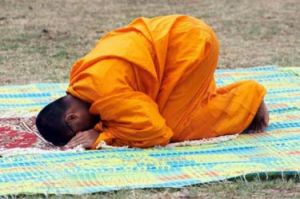Chö/Chöd Lineages associated with Machig Labdrön
One of the lesser known traditions of Tibetan Buddhism is that of Chö (Chod).
Althought it's roots lies with the Indian Mahāsiddha Dampa Sangye (Padampa Sangye) the Chö practice is unique in that it is the only buddhist tradition developed in Tibet. The origin of the "Mahāmudra Chö" tradition was the Tibetan woman Machig Labdrön (1055-1153), who is considered to be a nirmanakaya manifestation of Prajñāparamita. Having received numerous pure visions,
tantric and oral transmissions, Machig Labdrön taught a unique Dharma unknown even to the Indian paṇḍitas. Word of the widespread practice of Mahāmudra Chö in Tibet and Nepal was first viewed in India with great scepticism. A delegation of ācāryas was sent from Bodh Gayā to Tibet to test Machig Labrön and her teaching resulted in the acceptance of Mahāmudrā Chö as a valid and authentic Mahāyāna tradition. Thereafter it's practice spread even to India.
Although Chö as a distinct order ceased to exist hundreds of years ago, in Tibet, the practice was taken up by all major order s, with the exception of the Sakya Order . The Chö practice became very popular first within the Karma Kagyü, Drukpa Kagyu, and
was also taken up by the Gelug Order , especially at Ganden. The Nyingma Order , considering Machig Labdrön to be an incarnation of Yeshe Tsogyal, also practices Chö.
Below you find tables outlining a few of the various transmission lineages which Machig Labdrön recieved as well as links to the major Chö lineages: Tantra, Sutra, Sutra and Tantra, as well as the four daughters/"Nyen" lineage which ensued.
"means" female lineage:
"blessing" Buddha Śākyamuni ↓ Mañjuśri ↓ Nāgārjuna ↓ Āryadeva (Kanadeva) ↓ Āryadeva the Brahmin ↓ Kyotön Shakya Yeshe ↓ Sönam Lama ↓ Khupön ↓ Yum Chenmo ↓ Ārya Tārā ↓ Ḍākinī Sukhasiddhi ↓ Āryadeva the Brahmin ↓ Dampa Sangye ↓ Sönam Lama ↓ Yum Chenmo ↓ Buddha Śākyamuni ↓ Ārya Tārā ↓ Mañjuśri ↓ Āryadeva (Kanadeva) ↓ Āryadeva the Brahmin ↓ Dampa Sangye ↓ Sönam Lama ↓
Machig Labdrön (1055-1153)
↓ Gyalwa Döndrup ↓ Sūtra Lineage ↓ Khugom Chökyi Sengye ↓ Sūtra and Tantra lineage ↓ The four Daughters | Gyaltsen Ne Sönam Gyaltsen Palden Gyen Bumtso Rinchen Gyen
More Oral Transmission Lineages
lineage of the emptiness of percieved outer phenomenon lineage of the emptiness of inner percieving consciousness lineage of the uniting of percieved objects and percieving consciousness lineage of the offerings and the mandala practice
n.n
↓
n.n
↓
Nagarjuna
↓
Āryadeva (Kanadeva)
↓
Āryadeva the Brahmin
↓
Dampa Sangye
↓
Buddha Śākyamuni
↓
Maitreya
↓
Asanga (ca 290-360)
↓
Vasubandhu (316-396)
↓
Dampa Sangye
↓
Buddha Śākyamuni
↓
Mañjuśri
↓
Birawa (Virupa)
↓
Ḍākinī Sukhasiddhi
↓
Āryadeva the Brahmin
↓
Dampa Sangye
↓
Buddha Śākyamuni
↓
Ārya Tārā
↓
Mañjuśri
↓
Birawa (Virupa)
↓
Ḍākinī Sukhasiddhi
↓
Āryadeva the Brahmin
↓
Dampa Sangye
↓
Sönam Lama
↓
Machig Labdrön (1055-1153)
↓ Gyalwa Döndrup ↓ Sūtra Lineage ↓ Khugom Chökyi Sengye ↓ Sūtra and Tantra lineage ↓ The four Daughters | Gyaltsen Ne Sönam Gyaltsen Palden Gyen Bumtso Rinchen Gyen
Vajradhara ↓ Ārya Tārā ↓ ↓ ↓ ↓ ↓ Uḍumuwara Tantra ↓ Taming of Five Poisons and the Nagas ↓ The Quintessence that Dispels the Darkness of Ignorance ↓ Secret Mantra Lineage Vajrayāna ↓
Machig Labdrön (1055-1153)
↓ Thonyön Samdrup ↓ Tantra Lineage ↓ Khugom Chökyi Sengye ↓ Sūtra and Tantra Lineage ↓ The four Daughters | Gyaltsen Ne Sönam Gyaltsen Palden Gyen Bumtso Rinchen Gyen
Source
[[1]]
